Thatch - ... some things never change!
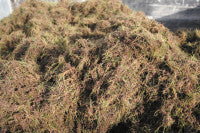 Head Greenkeeper Ken Barber goes to great depths to explain the problems and solutions to excessive thatch
Head Greenkeeper Ken Barber goes to great depths to explain the problems and solutions to excessive thatch
Thatch accumulation is one of the most common turf related problems experienced by today's course managers, yet this is nothing new. However, because of the ever-increasing demands placed on courses throughout the year, effective thatch management is essential.
Without this, there is a point where the long term quality of greens suffers, especially if committees within a club demand that management programmes, such as hollow coring or verti-draining, are carried out early spring or late autumn, when club competitions are fewer, but unfortunately when the benefits of such operations are also minimal. The hard facts are - if thatch is not correctly managed, clubs can expect to play on temporary greens at some point during the winter, and not just because they are covered in frost, but because they retain excessive moisture.
Thatch is more often the result of poor turf management than a problem that must be managed. If thatch levels are allowed to get out of control, putting surfaces can quickly deteriorate. Members then demand to know why they have to play on temporary greens most or part of the winter months. Then, at the first signs of summer, the greens develop large brown areas, usually as a result of dry-patch, and the irrigation is turned on to keep them alive. This ineffectual form of management only increases expenditure and will certainly not decrease thatch.
Methods of controlling thatch will vary from one manager to the next, and this is not just dependent on the structure of the greens. However, it is important to have a clear understanding of the basic components of thatch - what causes it, the effects on turf health and vigour as well as methods of control.
What is thatch?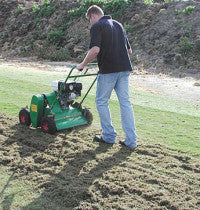
Thatch is the accumulation of organic residuals, consisting of, and intermingled with, dead, living or partly decomposed roots, stems and shoots, which develop between the soil surface and the actively growing green vegetation. Thatch only becomes a problem when its density causes grass plants to grow on top of the thatch layer rather than on the soil surface.
What is mat?
Thatch intermingled with mineral matter, usually as a result of topdressing. Around six millimetres of mat is advantageous as it promotes weed free, drought tolerant, free draining turf, which provides a cushion against the daily wear and tear caused by golf and maintenance traffic.
What causes excessive thatch?
Thatch increases when the rate of shoot production exceeds the rate of decomposition.
There are several influential factors which will contribute to, or accelerate, an increase in thatch levels and, consequently, management practices will vary from club to club depending on resources, cultural practices and ultimately, the knowledge and experience of the manager. One or several of these factors may be linked i.e. soil characteristics, grass species, soil pH, nutrient input, irrigation practices, and microbial populations.
The characteristics of a soil will no doubt have some influence. For example, high percentage sand greens, by their very nature, have low CEC (cation exchange capacity) and, more often than not, low microbial populations, essential in thatch decomposition. However, the benefits may compensate for the negatives with this method of construction, which is favoured more and more throughout Europe.
The operating costs of high percentage sand greens may be a little higher but, if built correctly and sound management practices are implemented, those costs can be redeemed through a full contented membership and maximising premium green-fee rates as the greens are free draining and playable throughout the winter months.
Soil greens, or push-up greens as they are often described, retain nutrients longer, generally have a higher CEC and microbial counts. Nonetheless, they are still vulnerable to thatch accumulation, although this is more likely as a result of compaction, reduced oxygen supplies to the root system, or excessive nutrient input.
The type of grass species and cultivar will effect the type of management regime implemented based upon the growth habit and aggressiveness of the desirable grass species. Bents, in particular the creeping bents, have a vigorous growth habit.
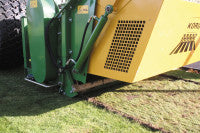 At the other end of the scale there are less aggressive growing species, such as the fine fescues, which can produce significant thatch due to their leaves, nodes and crowns being extremely resistant to decomposition due to their high lignin content. Although, with fine fescues, thatch levels take longer to accumulate than do other more vigorous growing grass species, their recovery rate is slower and therefore, any mechanical dethatching operation should be carried out in a less severe manner than with other grass species.
At the other end of the scale there are less aggressive growing species, such as the fine fescues, which can produce significant thatch due to their leaves, nodes and crowns being extremely resistant to decomposition due to their high lignin content. Although, with fine fescues, thatch levels take longer to accumulate than do other more vigorous growing grass species, their recovery rate is slower and therefore, any mechanical dethatching operation should be carried out in a less severe manner than with other grass species.
The soil pH can have an adverse effect on thatch development and, as the pH decreases, thatch is likely to increase - this is predominantly due to acid soils having a negative effect on microbial populations, reducing the potential for decomposition.
High applications of nitrogenous fertilisers will promote excessive thatch through the production of lush, succulent shoot growth. The applications of fertilisers containing the ammonium form of nitrogen, for example, sulphate of ammonia, are likely to increase acidity, while nitrate-containing fertilisers such as potassium nitrate may cause the soil to become more alkaline.
Excessive irrigation practices can cause soils to become waterlogged, resulting in reduced oxygen levels and inhibit microbial populations. There is also the potential of plant nutrients being lost through leaching.
What effects will thatch have on turf quality?
Excessive thatch will decrease the vigour of turf grasses by restricting the movement of water, gas exchange, nutrient availability, cold tolerance and drought stress tolerance, pesticide movement and degradation, and likely to increase pest and disease incidence.
Soft, spongy greens can quickly become saturated, while the soil immediately below can, in some cases, remain dry. An increase in thatch levels will reduce root depth and, as a result, grasses become more susceptible to changes in temperature. This can contribute to causing a hydrophobic condition (dry-patch) whereby soils may not necessarily be compacted but are hard to re-wet.
This is thought to be associated with certain disease pathogens producing a waxy coating or secretion surrounding soil particles or thatch, thus preventing water penetration.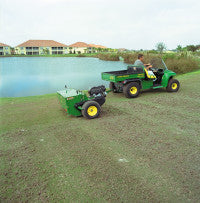
Thatch will have a negative effect on diffusion, the exchange of gases, oxygen (O2) and carbon dioxide (CO2) between the soil air spaces and the atmosphere, which will ultimately effect root development - with a reduction in oxygen and possibly an increase in carbon dioxide (CO2 toxicity) young root tips will die and older roots can become non-functional.
Thatch can effect the movement of nutrients by preventing penetration through the soil surface. Water soluble nitrogen sources are more likely to be lost to volatilisation, while non-mobile fertilisers, such as phosphorous, may not penetrate the thatch layer. Excessive nitrogen levels will induce rapid, succulent shoot growth, which is prone to scalping by mowing equipment and is frequently more of a problem on heavily thatched greens. Root growth, disease resistance, temperature, drought and wear tolerance is reduced as nitrogen levels are increased.
The rate and efficiency of pesticides can be affected by excessive thatch which can act as a second canopy layer through which pesticides must pass and which can physically bind the pesticide, reducing its ability to reach the target area. This could possibly reduce leach loss but may also reduce pesticide efficiency. Once a thatch becomes hydrophobic it can reduce pesticide efficiency by inhibiting penetration or causing runoff.
Thatch will harbour many types of disease pathogens waiting for environmental conditions to favour their activity. They survive as resting structures or saprophytes (organisms which live on dead organic matter) in thatch. For many turf grass pathogens thatch provides the perfect moist environment, but some say that most turf grass pathogens are airborne and, therefore, thatch cannot necessarily increase disease incidence. However, evidence suggests that excessive thatch reduces turf grass health and vigour and therefore, must surely increase disease incidence.
Options to control thatch
The prevention of excessive thatch is managed by cultural practices through either mechanical or biological means.
Biological control is linked to maintaining a healthy environment in order for micro-organisms to decompose thatch. It is important to remember that thatch accumulates over a period of time and the more vigorous species, such as bent grass, may produce excessive thatch, and, in a new green construction, in just two or three growing seasons.
So, from the early days of establishment, it is important to understand the growth habit of the grasses you are managing as this will dictate the kind of management regime you implement. If you inherit a thatch related problem then it is advisable not to attempt eradicating the problem in one season, but programme a series of operations over a period of one or two years, ensuring that any operation is carried out when environmental conditions favour thatch removal i.e. grasses are actively growing, thatch is moist and temperatures are adequate to support active growth and a rapid recovery.
As previously mentioned, thatch can be produced through various physical or environmental conditions, and the resulting characteristics of the thatch can alter from soft and holding water like a sponge, to dense and tightly bound, preventing moisture penetration.
So, totally different management programmes may be required. However, increasing oxygen to the soil environment will go a long way towards solving the problem. Fifty percent of thatch related problems could be resolved simply by aeration. Unfortunately, however, the more disruptive form of aeration the better the results. Hollow coring is undoubtedly the quickest and most effective way in which to reduce thatch, as this not only physically removes organic matter, but permits gas exchange, vital in maintaining a healthy microbial environment necessary in thatch decomposition.
It also assists with the movement of pesticides, nutrients and water through to the soil layer - how many times have you seen healthy white roots growing in tine holes or slits? Since hollow coring is disruptive to putting green surfaces, and subsequently upsetting to golfers, we tend to restrict this operation to one or two occasions each year. However, there are other forms of aeration which can also be beneficial in thatch reduction.
These include the use of solid, chisel or slit tines, designed to relieve compaction and permit air and water movement. Slit tines (thin bladed knives) can be used on a regular basis, not only for the benefits already mentioned, but also pruning tillers, yet causing minimal surface disruption. Sarel rolling is also a regular tool which can be used with minimal disruption, since it is working in the top 20mm and very beneficial in gaseous exchange and will also enhance microbial activity.
Consideration for the long term quality and condition of the golf course must always come first, and this means the timing of important course maintenance programmes should not be planned around club competitions.
Main competitions usually start at the beginning of April and not finish to the end of October - ideally the reverse should happen. Verti-draining or hollow coring greens during March or at the end of October will be far less beneficial in reducing thatch or encouraging a deeper root system than if programmed for late May and mid-September.
Too early in the spring before the soils have warmed up sufficiently, or too late in the autumn when soil temperatures have cooled, will result in poor putting surfaces for weeks and, in some cases, months before any noticeable recovery. On the other hand, carrying out this operation when soil temperatures are high will see recovery and good putting surfaces within days.
This will naturally vary according to the part of the country (north or south) you are working in.If well informed, and given the choice, it is more likely that members would rather have a week of disruption during the growing season than two months or more at the beginning and end of each growing season. Communicate to members and visitors via the club diary and notice board that, subject to favourable weather, the greens are to be hollow cored or verti-drained during a certain period! Then competitions and society bookings can be planned accordingly - to be pre-warned is to be prepared!
Topdressing greens, either as a separate programme or in conjunction with a coring programme, will dilute thatch and assist in producing an environment more conducive to healthy plant growth. The number of occasions greens are topdressed is dependent on the growth habit of your particular grasses.
Assuming that the underlying soils are of the desired specification, it is important that the topdressing material is compatible (similar size and composition) with the rootzone to avoid layering or a root break.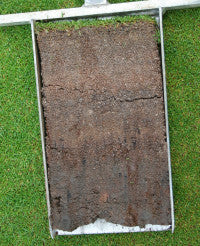
Irrigation management is reliant on water movement from the surface through to the rootzone effectively and for moisture to be retained in the macro and micro pore spaces. Irrigate when there is least wind, preferably early morning. The aim should be to wet the soils without exceeding infiltration and percolation rates. Research shows that roots do not "go in search of water."
However, roots only grow in moist soils and continually grow into new areas that have not yet dried out. So, in practice, this means that if only the upper layers of the rootzone remain moist, roots will be confined to these areas. If, by probing into the soil, it is revealed that the soil is dry a few centimetres below the surface, this will largely be due to root uptake and the root system will continue to shrink as it removes the moisture.
By assessing the moisture content within the first 15 - 20 centimetres of the soil profile using a soil probe, will ensure adequate moisture for healthy root development.
Fertiliser regimes will vary from course to course and will be dependent on the manager's ideals and philosophies. However, it is important to avoid excessive applications of nitrogen and monitor nutrient availability and pH readings via soil tests. Controlling thatch is essential in maintaining healthy turf, and problems relating to thatch accumulation can be avoided if sound management practices are implemented.
The R&A, who, in my opinion, is the leading body of golf, have promoted sustainable golf for a number of years. If you look at the various case studies on their website, they are working to ensure we can all lighten our environmental footprint while retaining the playing quality demanded by today's golfers.
These case studies include world renowned links courses in Scotland and Ireland, as well as inland courses in Wales and England. They all have something in common, they use minimal applications of fertiliser and pesticides and, more importantly, they manage their courses on surprisingly small budgets.
